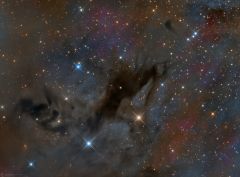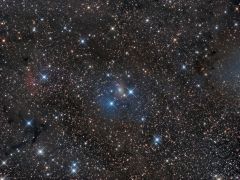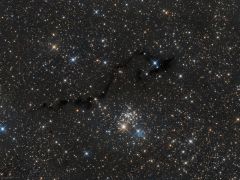-
Posts
349 -
Joined
-
Last visited
Content Type
Profiles
Forums
Gallery
Events
Posts posted by afesan
-
-
Congrats¡
-
This is Barnard 3, a dusty, gassy region of the galaxy about a thousand light years away where young stars are lighting up their neighborhood.Complex molecules similar to soot, called polycyclic aromatic hydrocarbons or PAHs. .So what’s going on here? Near the center is a F2 white-yellow star ( HD 278942) which is brighter and hotter than our Sun, and is flooding the surrounding material with ultraviolet light and a fast wind of subatomic particles (like the Sun’s solar wind, but a whole lot stronger and with a much, much farther reach). This has carved out a gigantic cavity in that stuff, creating a bubble about 25 light years in diameter — that’s huge: 250,000,000,000,000 kilometers across, more than 10,000 times the size of our solar system!The UV from the star is making the gas glow.In optical light (this object is a mess , with gas emitting light, reflecting light, and dust absorbing it. When gas is lit up this way around a star, it’s called a Strömgren sphere, after the astronomer Bengt Strömgren who did the first theoretical work on them.An infrared image of the area can be seen here:http://wise.ssl.berkeley.edu/gallery_Barnard3.htmlCredit: (Phil Plait, Discover Magazine, December 2011)Link to more info and high resolution image: http://afesan.es/Deepspace/slides/Barnard%203%20%28Perseus%29.htmlCS ¡Antonio
-
-
Very promising image ¡¡... You´re on the road ¡

-
-
Great¡¡¡. Agree with George... Color is top ¡¡
-
Congrats ¡¡¡
Well done ¡
-
-
Glad you like it, Konihlav ¡..

-
 Thanks ,Mark ¡
Thanks ,Mark ¡ -
Nice internal structures detail and colour, Ron ¡
-
Thank you, Ron ¡
-
DG 181, DG 182 (Dorschner+Gurtler catalogue) are two tiny blue reflection nebulas located between the LDN´s 1175 and 1184, into the cloud TGU640 of Cepheus constellation..Rarely imaged (or never imaged ? ) the area also contains IR objects such as IRAS 22148+6033,IRAS 22151+6040,IRAS 22158+6041 ans X-Ray objects as 1RXS J221635.3+604813 .The whole area is inmersed into a mix of dust and reflections , making it a difficult task for astrophotographers. A lot of hours were invested in order to present it with some detail and colour.Many thanks to Sakib Rasool for pointing these targets.
Hi.resolution: http://afesan.es/Deepspace/slides/DG%20181%2CDG%20182%2C%20LDN%201175%2CLDN%201184%20%28Cepheus%29.html
-
Nice details , Ron ¡...
-
You will can value also how the pass of Milky Way over zenith also affects SQM readings :-)... Mine is working here from past couple of years ( LE version) ...and works OK. As you stated.. Cloudwatcher and SQM instruments have different purposes... But SQM helps me to establish if my images can be of quality and to determine point when I usually begin to image : I never image until SQM readings are over 21.1 .. Evidentey this is a local measure imposed to myself...
You will enjoy it and will find your own utilities..
Antonio
-
Fantastic one with a DSLR...¡.. Really did you remove the bayer Matrix ?? .. Then it´s a big improvement for narrowband, indeed...¡
Congratulations¡
Antonio
-
Hi Pavell.
Fantastic image... A gem ¡¡ .. Just a little appreciation of a problem into the upper-center-left side of sensor with stars out of focus with respect to the image. Spikes and star sizes are different--- so it seems to me there is a little problem of distances in the optical train...?..
Colour, procesing and details. overall...are great ¡-
Congrats¡
Antonio
-
Welll.. I just image with MLPT and Sequencer all over the night in a remote-robotic observatory ....without any problems at all. I always use a full model of the sky and MLPT.. , but this is just a personal taste.. I like to have always a previous model for the whole Sky.
My subframes are always into the range of 10-15 minutes LRGB and 20-30 minutes narrowband. No problems at all. Perfect round stars. If you experience problems I will re-check the hardware area ( balance, counterweights, motors parameters) and , of course... mirror movements or focuser sights... Most of my initial problems came for movements of primary mirror (in case of a reflector)....
Just my two cents...
CS ¡
Antonio
-
Sure ¡¡¡..I agree autumn/winter skies are great for nebulas and great imaging projects... furthermore ¡¡ ..nights are longer ¡¡ Hoorayyy¡¡

-
" Sea Horse Dark Nebula " aKa Open cluster NGC 654,VdB6,LDN 1332,1334,1337 (Cassiopeia) * August-September 2014 * ASA N12 astrograph (f/3.6,1078mm) * DDM85 mount * FLI ML8300 at -25ºC * Optec LRGB filter set * L.520m R:180m G:160m B:210m * Unguided * NGC 654 is a young cluster,with an age of about 14 million years.The cluster`s 80 measured members (7th magnitude and fainter) appear in little clumps scattered across a mere 6´of sky,or 14 lightyears. Astronomers have taken keen interest in NGC 654 because of it displays nonuniform extinction across its face,with stars reddened by about 1 magnitude on average.Color excess indicates the amount of interstellar reddening suffered by the light from the star when it passes through dust in space.Data from Indian Astronomer Biman J. Medhi and colleagues (2008), show evidence for the presence of at least two layers of dust along the line of sight to the cluster, which lies at a distance of about 7800 light-years.The 7th magnitude yellow supergiant star HD 10494 is a likely member of this cluster with a recessional velocity of about 31km/sec.They estimate the distances to the two dust layers to be about 652 and 3300 light-years, placing the clouds much closer to the Sun than the cluster.The foreground dust grains,appear to be responsible,then, for the nonuniform extinction towards the cluster,whose least reddened stars lie close to the cluster center. VdB 6 is a little reflection nebula. The star wrapped in vdB 6 is listed as HIP 8074 of magnitude 9.66, located in the Perseus arm, which gives the nebula a distinctly bluish color.
More resolution image : http://afesan.es/Deepspace/NGC%20654,VdB6,LDN%201332,1334,1337%20(Cassiopeia)_jpg_orig.htmlCs
Antonio
-
I know what you feel, Pavel. I live at north of Spain..in a permamently covered skies and high humidity covered area due to mountains reefs. For years I imaged in those unprecedible conditions until I could send my equipment to Southwest area of Spain..My website was named "Astronomy under the clouds" :-)
Very nice result for 5 hours¡ ¡
Go on ¡
Antonio
-
Wow¡..
A rarely imaged target Ron¡
Good job ¡
Antonio
-
Thanks, guys¡
Well.. I simply choose those rare targets because it´s there¡¡ .. Sometimes it is a suggestion from a semi-professional astronomer...,sometimes I like to look at lost and forgotten catalogues ( as a library mouse)..but most times is because I simply prefer don´t to have a previous image from target into my brain. ..
Well..maybe it can be so simple as I am an outsider ?... uh ?

-






Barnard 3
in Deepsky
Posted
Thanks Mark ¡..